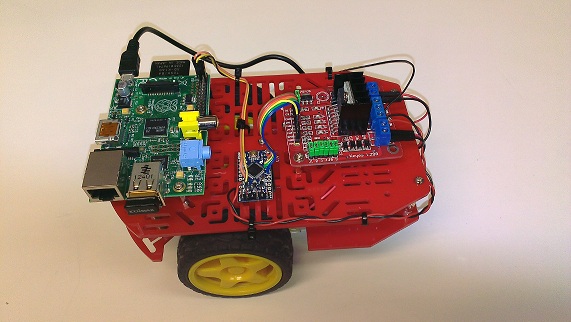Back from the APL meeting in Hamburg, where my C3Pi made it’s first appearance on German soil (and a few days meeting with APL users in Milan). I’ve extended the control program which was used to make last week’s figure 8 video to give me some “hand controls”. I do appreciate that it is inadvisable for humans to control motor vehicles directly, but in the privacy of my own home I have risked a little careful driving:
The APL Code
You can see the latest code at https://github.com/APLPi/APLBot. However, beware that significant changes will be made next week – both to the APL code and the Arduino / I2C interface layers. We will be adding support for our first sensor – an Infra-Red sensor that will allow us to measure the distance to the nearest obstacle (in front of the ‘bot) – and this requires some extensions.
The APL code currently consists of three files: I2C.dyalog, DyaBot.dyalog and DrivePi.dyalog. These need to be placed in the same folder on your C3Pi.
The I2C.dyalog file relies on the library lib2c-com.so, which will be installed along with Dyalog APL for the Pi when this becomes available.
The final piece of the puzzle is the control program for the Arduino. That’s in APLPi/I2CArduinoComm. Install it by following the relevant part of Jason’s instructions on building your own C3Pi.
The three APL code files implement the following layers:
I2C: A namespace which loads libi2-com.so and makes four interface functions available in the active workspace. Strictly speaking, this file belongs in the libi2c-com repo, and will move there when I have time to co-ordinate rewriting some test cases with Liam.
DyaBot: A class, built upon I2C, which allows APL applications to control the robot by setting a field named “Speed” to a 2-element vector containing values between ¯100 (full reverse) and 100 (full speed ahead) for each of the 2 wheels.
DrivePi: A namespace, built upon DyaBot, containing a function Run which provides a very simple “game interface” for driving the C3Pi, and a function Play which accepts 3-column matrices of (Right Wheel Speed, Left Wheel Speed, Duration) records, which are “played back”.
What next?
The ultimate goal of our project is to write some code which allows the C3Pi to perform Simultaneous Localization and Mapping (SLAM): The robot should be able to examine its surroundings, build a map, and accept high-level instructions to move from point to point, avoiding obstructions. As mentioned above, we’ll be addding the first collision-avoidance sensor next week. Once that is done, I’ll be back to discuss the other sensors that we are planning to add to the C3Pi in the coming weeks. I hope that some of you will join us in building your own robots and helping write the software!


 Follow
Follow